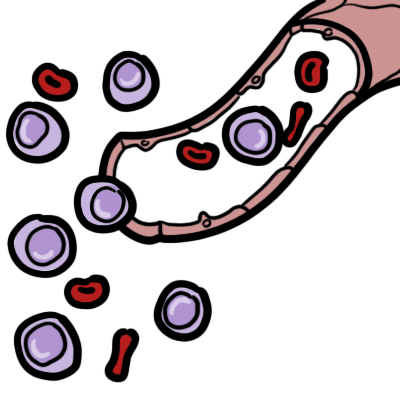Leukaemia


Leukemia is a common malignancy in children and adults that occurs when alterations in normal cell regulatory processes cause uncontrolled proliferation of hematopoietic stem cells in the bone marrow.
Leukaemia: Clonal proliferation of hematopoietic stem cells in the bone marrow
Acute Leukaemia: Clonal proliferation of hematopoietic stem cells in the bone marrow that develops rapidly, requires immediate treatment and often presents with symptoms. In acute leukaemia the cells in the bone marrow are immature (blasts).
Chronic Leukaemia: clonal proliferation of hematopoietic stem cells in the bone marrow that develops slowly, treatment may be delated and often presents asymptomatically. In chronic leukaemia the cells in the bone marrow are still able to mature.
Lymphoma: Heterogeneous group of haematological neoplasms, characterised by proliferation of malignantly transformed T or B lymphocytes. The proliferation occur typically in the lymph nodes unlike leukaemia which occir in the bone marrow and result in overcrowding.
Its important to know that Leukaemia can be divided into acute and chronic and then further divided into its cell lineage. Remember that this makes each of them very different diseases.
Acute lymphoblastic leukemia occurs more often in children, whereas the other subtypes are more common in adults.
Patients will AML fall ill suddenly and deteriorate fast, because of Infection, Bleeding (low platelets) and Hyperviscosity.
| Causes of Panytopaenia |
| Bone marrow failure – Aplastic anaemia |
| Drugs |
| Bone marrow infiltration – Lymphoma, leukaemia, myeloproliferative disease, myelodysplastic |
| Hypersplenism |
| SLE |
| Sepsis |
| Alcohol |
| Radiation |
| SUMMARY OF MAJOR LEUKAEMIA | ||
| Subtype | Description | Typical Group affects |
| Acute lymphoblastic leukaemia | Blast cells on peripheral blood smear or bone marrow aspirate | Children (53% <20yo) |
| Acute Myelogenous leukaemia | Blast cells on peripheral blood smear or bone marrow aspirate; Auer rods on peripheral smear | Adults |
| Chronic lymphoblastic leukaemia | Clonal expansion of at least 5,000 B lymphocytes per μL (5.0 × 109 per L) in the peripheral blood | Older adults (85% >65yo) |
| Chronic Myelogenous leukaemia | Philadelphia chromosome (BCR-ABL1fusion gene) | Adults |

Please confirm you want to block this member.
You will no longer be able to:
Please allow a few minutes for this process to complete.
Discussion